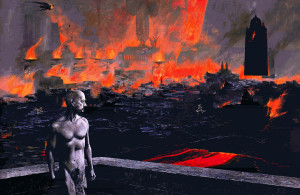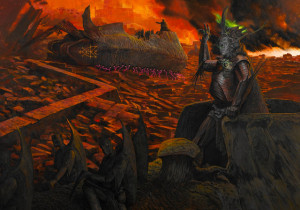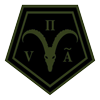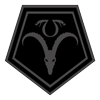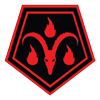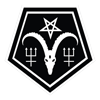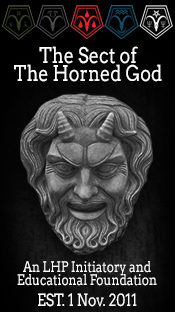The Left-Hand Path to Hell
by Thomas LeRoy
The concept of Hell has been a part of history for at least 4,000 years. Many different cultures had some form of Hell, the Mesopotamian being one of the earliest. It was a nether region filled with demons where the ancient Gods consigned evildoers to suffer endless torment. The later Christian interpretation of Hell was built upon Hebrew ideas, which in time became, like in the case of the Mesopotamian tradition, a place of punishment for the wicked. But in the Old Testament, there’s only one word which indicated anything close to Hell, and that is sheol. It appears originally to have been the Hebrews’ version of the Sumerian and Babylonian Irkalla, or Netherworld, also referred to more poetically as “the House of Dust and Darkness.” Strangely, early Christians did not write extensively on Hell and appear not to have taken it as literally as many do today. But when documented, Hell was pictured as an inferno, a place of flames and cruel heat, where Satan lived and sinners suffered as demons boiled them in kettles or stabbed them with pitchforks, punishments tailored to fit specific sins.
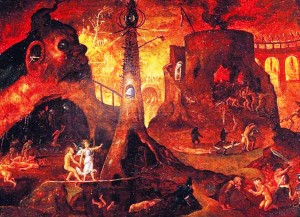
According to Carl Gustav Jung, Hell represents, among every culture, the disturbing aspect of the collective unconscious. The collective unconscious is universal. Every human being has been endowed with this psychic archetype-layer since his/her birth. One can not acquire this strata by education or other conscious effort because it is innate; for deep in our subconscious the same symbols speak to similar meanings across different cultures and unrelated time periods. The collective unconscious, this universal library of human knowledge, is the very transcendental wisdom that guides us. Jung stated that all religious experiences must be linked with the experience of the archetypes of the collective unconscious. Thus, all gods and demons, and even their locations such as Hell, are part of a psychic experience of the path that leads one to the realization of our psychic wholeness. In Jungian psychology, Hell would then be the place where the “shadow” resides. ‘‘The shadow,’’ wrote Jung, is ‘‘. . . that hidden, repressed, for the most part inferior and guilt-laden personality whose ultimate ramifications reach back into the realm of our animal ancestors and so comprise the whole historical aspect of the unconscious’’. The shadow was originally Jung’s poetic way of conveying the prominent role played by the unconscious in both psychopathology and the ongoing problem of evil. Also concerned with that pathological mental state known as ‘‘demonic possession”, Jung’s psychological construct of the shadow corresponds to, yet differs, from the idea of the Devil or Satan in theology. Born a parson’s son, Jung was inundated in the Protestant faith, he also studied the meaning behind Catholic iconography, and researched the great religious traditions from around the world. But, being a physician and psychiatrist, he used the more rational and less esoteric terms like ‘‘the shadow’’ and ‘‘the unconscious’’ instead of the traditional religious language of god, devil, or demons.
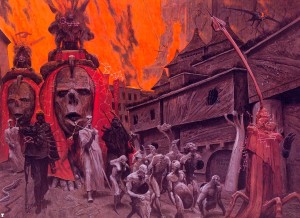
Just above the level of the collective Hell lies the personal Hell. This Hell is a place of personal demons that feed the shadow in the lower realm. And from time to time most of us feel a need to roam in this Hell. We all feel guilt, so we feel a need for torment, thus, we feel a need for Hell. The philosopher Friedrich Nietzsche described guilt as a disease that humanity caught when it formed its first social communities. But even though we live in artificial constructs we call nation states, under repressive executive authorities we call governments, our primitive instincts have never faded away. Instead, we turned our instincts for cruelty inwards upon ourselves because social laws prohibit violence. Because we internalize these instincts, we grow sick of existence. Nietzsche refers to this sentiment as the worst and most insidious illness ever to afflict human-kind. An illness from which we have not yet recovered.
So, as for us on the left-hand path, what are we to do? The collective hell is there whether we like it our not, but how should we confront this personal Hell of our own making? First, we must acknowledge that it is very real. Next, we must free up our minds and enter our personal Hell on our own accord, without that masochistic justification for torment created by guilt. We have to deny guilt and the Christian slave morality that permeates our society. In truth, we should have let guilt and slave morality go when we first set foot upon the Path. While in Hell, though, we must confront the dark entities that dwell in that abyss. We must stare them down, and in some cases, embrace them. But we should never turn our backs on them. Also, in the fires of Hell burns the source of our Black Flame, that spark of individualistic self-awareness. It was in our personal Hell that we first saw its glow, and from Hell we must lift it up and initiate it into our lives.
In the end we should never let our personal Hell curse our existence. It should be a means of empowerment for the Black Flame is fueled by Hell’s torments; and never forget that it is the Black Flame that lights our Path.
